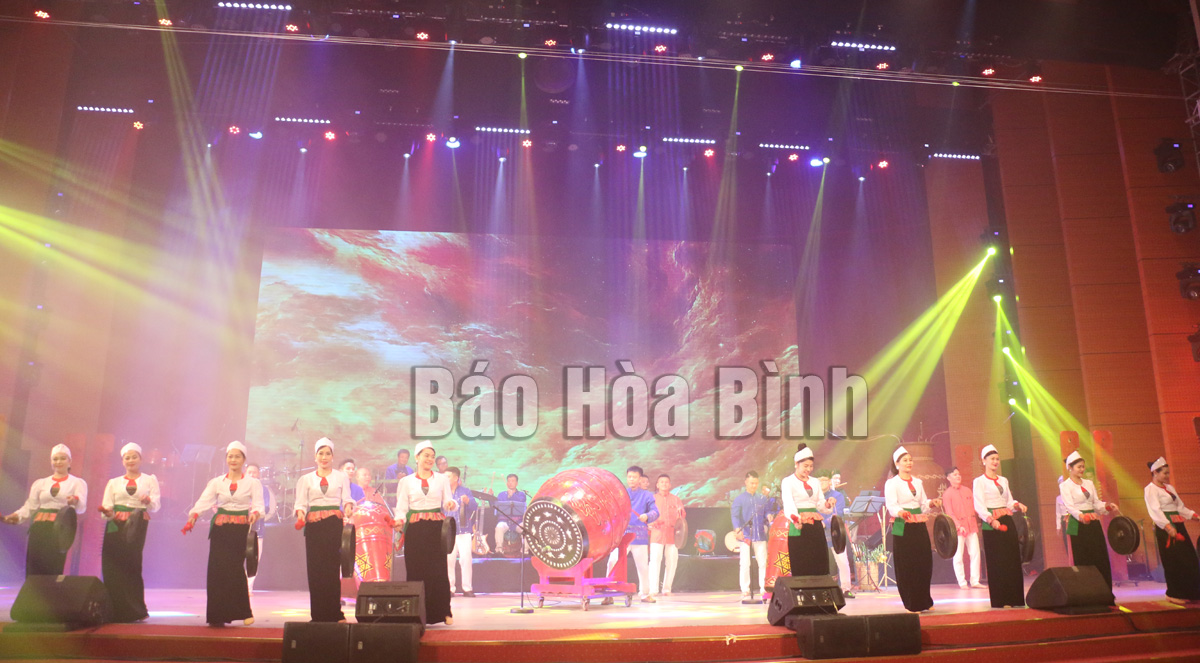
(HBO) - An art programme, themed "Awakening Muong Gongs" and performed by the Hoa Binh art troupe, has won a gold and a silver medal at the 2023 national solo and ensemble ethnic musical instruments competition.

The performance of the provincial art troupe at the
2023 national solo and ensemble ethnic musical instruments competition.
The 30-minute programme entailed carefully prepared
performances of Muong gongs and flutes, leaving a strong impression on the audiences.
People’s Artist Huynh Tu said: "Running this programme was a
fortunate experience for me. I have a profound impression of culture in Hoa
Binh. My team and I chose to build the programme mainly based on the gong
culture. Its title and opening performance, both titled ‘Awakening Muong
Gongs,’ aim to present the authentic colours of Hoa Binh at the competition.”
Singer Vu Thuy Lien noted participating singers had to join
the band to show the audience the artistry, movements and rhythms of the works staged.
People’s Artist Hong Tam said joining the competition is a
pride for all artists, musicians, and actors of the troupe. It is also a source
of pride for her to bring the melodies of gongs from Hoa Binh to the audience
and music lovers from across the country. "Hopefully, our programme will
introduce Hoa Binh's culture and the soul of the Muong land to people
nationwide,” she said delightedly.
Bach Cong Thi, head of the provincial art troupe, said the
programme deeply explores the art of the Muong musical performance, with the
gongs as the main focus. In Muong music, the gongs hold a significant position,
widely used in daily life and religious rituals. Along with the instrument, the
melodies of Muong music are also expressed through other instruments such as
flutes, two-string fiddles, and sixteen-string zithers. "Our creative team has
built a programme that truly represents the cultural identity of Hoa Binh,” he
said./.
With an increasingly vibrant and widespread emulation movement aimed at building cultured residential areas and cultured families, Yen Thuy District has been making steady progress toward improving both the material and spiritual well-being of its people, while fostering a civilized, prosperous, beautiful, and progressive community.
Once lacking recreational spaces and community facilities, Residential Group 2 in Quynh Lam Ward (Hoa Binh City) has recently received attention for the construction of a new, spacious, and fully equipped cultural house. The project followed the model of state support combined with public contributions in both labor and funding.
The "All people unite to build cultural life" movement, which has been effectively integrated with Kim Boi district’s socio-economic development goals, is fostering a lively spirit of emulation across local residential areas, hamlets, villages, public agencies, and enterprises. In addition, through the initiative, traditional cultural values are being preserved and promoted, while community solidarity and mutual support in poverty reduction and economic development are being strengthened.
A working delegation of the Hoa Binh provincial People’s Committee led by its Permanent Vice Chairman Nguyen Van Toan on June 11 inspected the progress of a project to build the Mo Muong Cultural Heritage Conservation Space linked to tourism services in Hop Phong commune, Cao Phong district.
Born and growing in the heroic land of Muong Dong, Dinh Thi Kieu Dung, a resident in Bo town of Kim Boi district, in her childhood was nurtured by the sweet lullabies of her grandmother and mother. These melodies deeply imprinted on her soul, becoming an inseparable part of her love for her ethnic group's culture. For over 20 years, this love for her hometown has driven Dung to research, collect, and pass down the cultural values of the Muong people to future generations.
In the final days of May, the Ethnic Art Troupe of Hoa Binh Province organized performances to serve the people in remote, mountainous, and particularly disadvantaged areas within the province. These were not just ordinary artistic shows, but they were the meaningful journeys aimed at spreading cultural values, enhancing the spiritual life of the people and contributing to the preservation of ethnic minority cultural identities.



